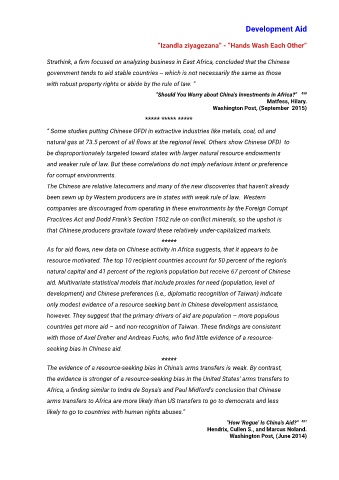Page 409 - Volume 2_CHANGES_merged_with links
P. 409
Development Aid
“Izandla ziyagezana” - “Hands Wash Each Other”
Strathink, a firm focused on analyzing business in East Africa, concluded that the Chinese
government tends to aid stable countries -- which is not necessarily the same as those
with robust property rights or abide by the rule of law. “
"Should You Worry about China's Investments in Africa?" 460
Matfess, Hilary.
Washington Post, (September 2015)
***** ***** *****
“ Some studies putting Chinese OFDI in extractive industries like metals, coal, oil and
natural gas at 73.5 percent of all flows at the regional level. Others show Chinese OFDI to
be disproportionately targeted toward states with larger natural resource endowments
and weaker rule of law. But these correlations do not imply nefarious intent or preference
for corrupt environments.
The Chinese are relative latecomers and many of the new discoveries that haven't already
been sewn up by Western producers are in states with weak rule of law. Western
companies are discouraged from operating in these environments by the Foreign Corrupt
Practices Act and Dodd Frank's Section 1502 rule on conflict minerals, so the upshot is
that Chinese producers gravitate toward these relatively under-capitalized markets.
*****
As for aid flows, new data on Chinese activity in Africa suggests, that it appears to be
resource motivated. The top 10 recipient countries account for 50 percent of the region's
natural capital and 41 percent of the region's population but receive 67 percent of Chinese
aid. Multivariate statistical models that include proxies for need (population, level of
development) and Chinese preferences (i.e., diplomatic recognition of Taiwan) indicate
only modest evidence of a resource seeking bent in Chinese development assistance,
however. They suggest that the primary drivers of aid are population – more populous
countries get more aid – and non-recognition of Taiwan. These findings are consistent
with those of Axel Dreher and Andreas Fuchs, who find little evidence of a resource-
seeking bias in Chinese aid.
*****
The evidence of a resource-seeking bias in China's arms transfers is weak. By contrast,
the evidence is stronger of a resource-seeking bias in the United States' arms transfers to
Africa, a finding similar to Indra de Soysa's and Paul Midford's conclusion that Chinese
arms transfers to Africa are more likely than US transfers to go to democrats and less
likely to go to countries with human rights abuses.”
"How 'Rogue' Is China's Aid?" 461
Hendrix, Cullen S., and Marcus Noland.
Washington Post, (June 2014)

